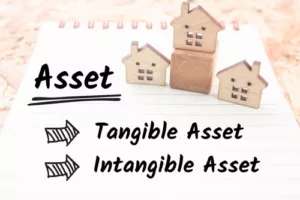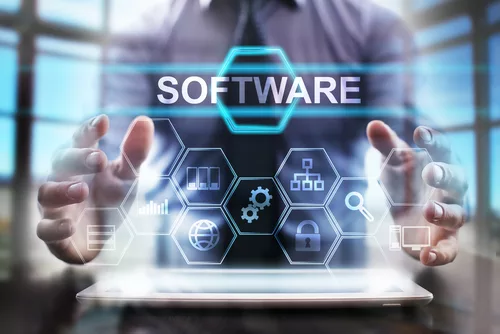- Posted on
- Kortney Murray
- 0
More and more companies are relying on computer software in their day-to-day operations. These assets must be valued and included in financial statements. To do so, you will need to know if the software is considered a tangible or intangible asset. So, is software an intangible asset? In this article, we will discuss the answer in more detail.

What are Tangible and Intangible Assets?
In previous articles, we’ve talked about both tangible and intangible assets. However, in this article, we must parse the specific similarities and differences between them.
- Tangible assets: Tangible assets are typically those business items that can be physically touched. They are used to produce measurable profit within the company operations, usually long-term. Property, plant, and equipment (PP&E) are classified as tangible assets.
- Intangible assets: The simple definition of an intangible asset is an asset that cannot be physically touched. Like tangible assets, they are also meant to be used long-term by the business. Oftentimes, intangibles are intellectual assets, which makes it hard to determine their precise valuation and future economic benefits. If you don’t know how much benefit they carry, the value remains unclear. Examples of intangible assets include software licenses, trademarks, patents, films, intellectual property, customer lists, and copyrights.
There are different accounting procedures for different types of assets, and all assets must be classified in the right category. For instance, cloud computing, developmental software, multi-use software, and shared software will all have different accounting treatments associated with them.
That being said, is computer software an intangible asset? Most people will consider it to be intangible since it cannot be touched. Generally, it is considered an intangible non-current asset and is classified alongside other fixed assets aka capital assets. This is because computer software is made for long-term use, typically over 12 months time.
An intangible asset like this will be a high expense for the company. However, there are some exemptions in which software can be considered tangible, and therefore will have another set of beneficial accounting rules applied. Accounting rules allow some exceptions for computer software to be classified as PP&E and capitalized upon.
If the asset is not capitalized on the balance sheet, it will instead be expensed on the Income Statement. The balance sheet is a company’s financial statement that reports assets, liabilities, and shareholder equity at a specific point in time. Capitalizing on an asset refers to the cash expenditures recognized as an asset on the balance sheet instead of expenses listed on the income statement.
The cost of the asset is reconciled over its useful life instead of solely expensed in the reporting period of time it was purchased. When software is capitalized, your business can delay the full expense of the asset on the balance sheet. As it turns out, some accounting rules allow businesses to capitalize on software, as they would any tangible asset.
Specifically, IAS 38 made it possible for companies to capitalize software costs on the balance sheet as non-current assets. It is important that not all software can be capitalized, however. The software must first be properly classified and treated as PP&E, as stated:
“Some intangible assets may be contained in or on a physical substance such as a compact disc (in the case of computer software), legal documentation (in the case of a licence or patent) or film. In determining whether an asset that incorporates both intangible and tangible elements should be treated under IAS 16 Property, Plant, and Equipment or as an intangible asset under this Standard, an entity uses judgment to assess which element is more significant.
For example, computer software for a computer-controlled machine tool that cannot operate without that specific software is an integral part of the related hardware and it is treated as property, plant, and equipment. The same applies to the operating system of a computer. When the software is not an integral part of the related hardware, computer software is treated as an intangible asset.”
Therefore if an asset is used to deliver goods and services, it can be classified as a tangible asset. For example, software used by a graphic design company could be considered tangible since it helps deliver the graphic design service to customers. On the other hand, software used to count asset inventory at a warehouse is not considered tangible since there is no direct relation with the customer.
Therefore the software asset would be considered intangible. To explore tangible assets further, let’s take a closer look at PP&E.
How to Determine if Software is PP&E
Property, plant, and equipment or PP&E is another term for the tangible physical assets of a business that are meant for long-term use within the operations. Examples include things like office equipment, buildings, machinery, land, furniture, and vehicles.
The software must meet certain criteria to be considered PP&E by accounting standards. Here are those standards for reference:
“The Federal Accounting Standards Advisory Board (FASAB) Statement of Federal Financial Accounting Standards (SFFAS) No. 10, Accounting for Internal Use Software introduces a set of rules about the cost of internal software and transforming it into value as an asset on the balance sheet. It states that: “Entities should capitalize the cost of software when such software meets the criteria for general property, plant, and equipment (PP&E). General PP&E is any property, plant, and equipment used in providing goods and services.”
To be classified as PP&E, SFFAS No. 6 states that the assets must meet the following recognition criteria:
- They (the assets) have estimated useful lives of 2 years or more.
- They are not intended for sale in the ordinary course of operations.
- They have been acquired or constructed to be used or are available for use by the entity.
You may notice that there are no dollar amount thresholds stated in these accounting standards. This means that your management teams have some discretion in choosing to capitalize on the software or not. The decision-makers are then able to establish their capitalization thresholds.
These thresholds cannot include any expenses of the software after testing has been completed. SFFAS No. 10 states: “Costs incurred after final acceptance testing has been completed should be expensed. Where the software is to be installed at multiple sites, capitalization should cease at each site after testing is complete at that site.”
If the software was developed by a contractor, you will include the bulk cost of the amount paid to the vendor and the asset’s useful life when calculating the threshold. However, you cannot capitalize on the software if it is an integral part of PP&E. SFFAS No. 10 states:
“For example, if the software is a part of a weapons system, it would not be capitalized but included in the cost of investing in that weapons system. On the other hand, software used to accumulate the cost of acquiring that weapons system or to manage and account for that item would meet the criteria for general PP&E and should be capitalized.”
OWNERSHIP AND CREATION OF COMPUTER SOFTWARE
Capitalizing or recording the cost of computer software can be done once ownership of it has been transferred. At this point, both risk and reward fall to the new owner. However, this does not mean that the software has been paid for yet, simply that ownership changed. Therefore, capitalizing or recording the asset is not contingent on payment, only on the transfer of ownership.
Capitalizing on purchased software simply is done as a one-time cost upfront. But computer software can not only be bought, it can be created in-house within a company. This means both time to create it and the cost associated with building it should be capitalized on.
However, there can be several phases that involve software development which makes it more difficult to record costs. The development of internal software programs may or may not be successful. And only if the feasibility and development of the product are forecasted to be successful will it be capitalized on.
So instead of a one-time upfront cost, software development costs will not be capitalized until most of the work has already taken place on seemingly successful computer software.

How to Capitalize Computer Software
Once you’ve determined to capitalize on the computer software, the financial team can record its costs on the balance sheet. This financial reporting will not fully recognize its expense at once but will delay the expense. Then the team can either amortize or depreciate its costs on a straight-line basis over the estimated useful life. Typically for software, useful life is expected to be between two and five years.
INTERNAL USE SOFTWARE CAPITALIZATION
For the computer software used for internal use, the GAAP accounting procedures will vary depending on the phase of the project. As we’ve previously stated, you can’t capitalize on the internal use functions. However, you can capitalize on the costs related to the acquisition of the new software or adding functionality to existing ones.
Otherwise, the remaining operational expenses will not qualify. The stages of internal use capitalization include:
- Preliminary stage: During this stage, you’ll want to record any costs relating to decision-making regarding the software (including discussions on performance requirements), resource allocation, supplier meetings, and selection of the technology.
- Application development stage: As the software is being internally generated, your company can capitalize on any developmental costs regarding its programming, testing, and installation of hardware, labor, fees for third-party development, the purchase price (including interest), and any travel expenses relating to the development.
- Implementation stage: During the final stage, you can record the costs as they happen. Since the software is being used at this point, any costs will typically include things like maintenance and employee training.
EXTERNAL USE SOFTWARE CAPITALIZATION
The software that is used directly for generating revenue through being sold, leased, or marketed to external users will be capitalized on. This process is more strict than internal use software, and there are specific rules and standards that businesses must follow. The following are the stages of that process:
- Preliminary stage: Any costs that are generated from activities performed to discuss the objective of the software will be capitalized. This includes any costs involving research, prototyping, design work, and initial planning that is done before the software is developed.
- Technologically feasible stage: Any costs involving the planning, designing, coding, and testing of new software, its design, or its working models can be capitalized.
- Available for sale stage: When the software is up and running for sale, lease, or marketing, all expenses of these processes should be recorded and capitalized. This includes any maintenance, support, correction of errors, and troubleshooting.
Even though it is technically nonphysical, computer software does have a useful life. This helps determine its value to the company. But unlike physical assets, the software doesn’t technically depreciate. There is no wear and tear as tangible objects do. Regardless, the software can be outdated, rendering it useless whenever that does happen. Its value can quickly change.
To amortize the software, the company must somehow reflect its usage of it over time. You can do this by subtracting the accumulated amortization from the software’s purchase amount:
Software purchase amount – Accumulated amortization =
To find the amortization rate, you will need to find the amortization methodology used for that particular software. Typically the amortization rate used is 3 years or 36 months.
Intangible assets that have an indefinite useful life will not be amortized. Instead, they are tested for impairment annually or whenever is best for the company. The asset is said to be impaired when the asset’s carrying amount is greater than its fair value. For instance, trademarks and trade names will help generate revenue indefinitely, which would qualify them as indefinite-lived intangible assets.
Update Your Accounting Policy
Is software an intangible asset? The answer: yes and no. It depends on how it is used in your business. If it is used to deliver goods and services, it can be classified as a tangible asset. But if it is used within the operations of the business, it can be considered intangible.
Talk to your financial advisor about updating your accounting policy to reflect the value of your computer software.
If You Like Please Share It: